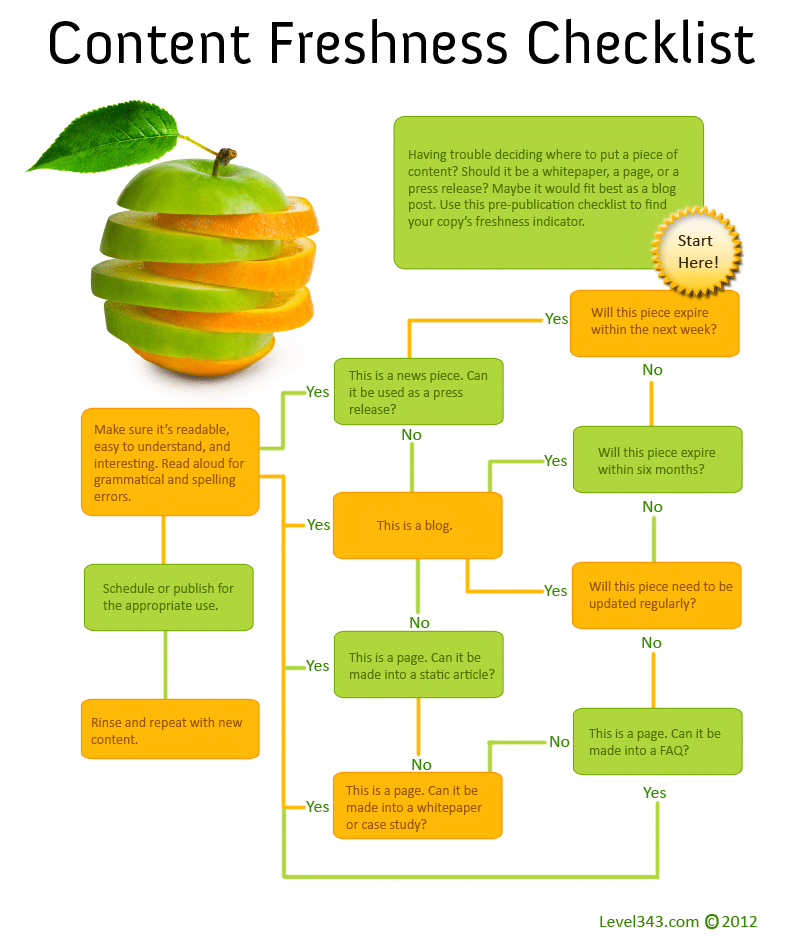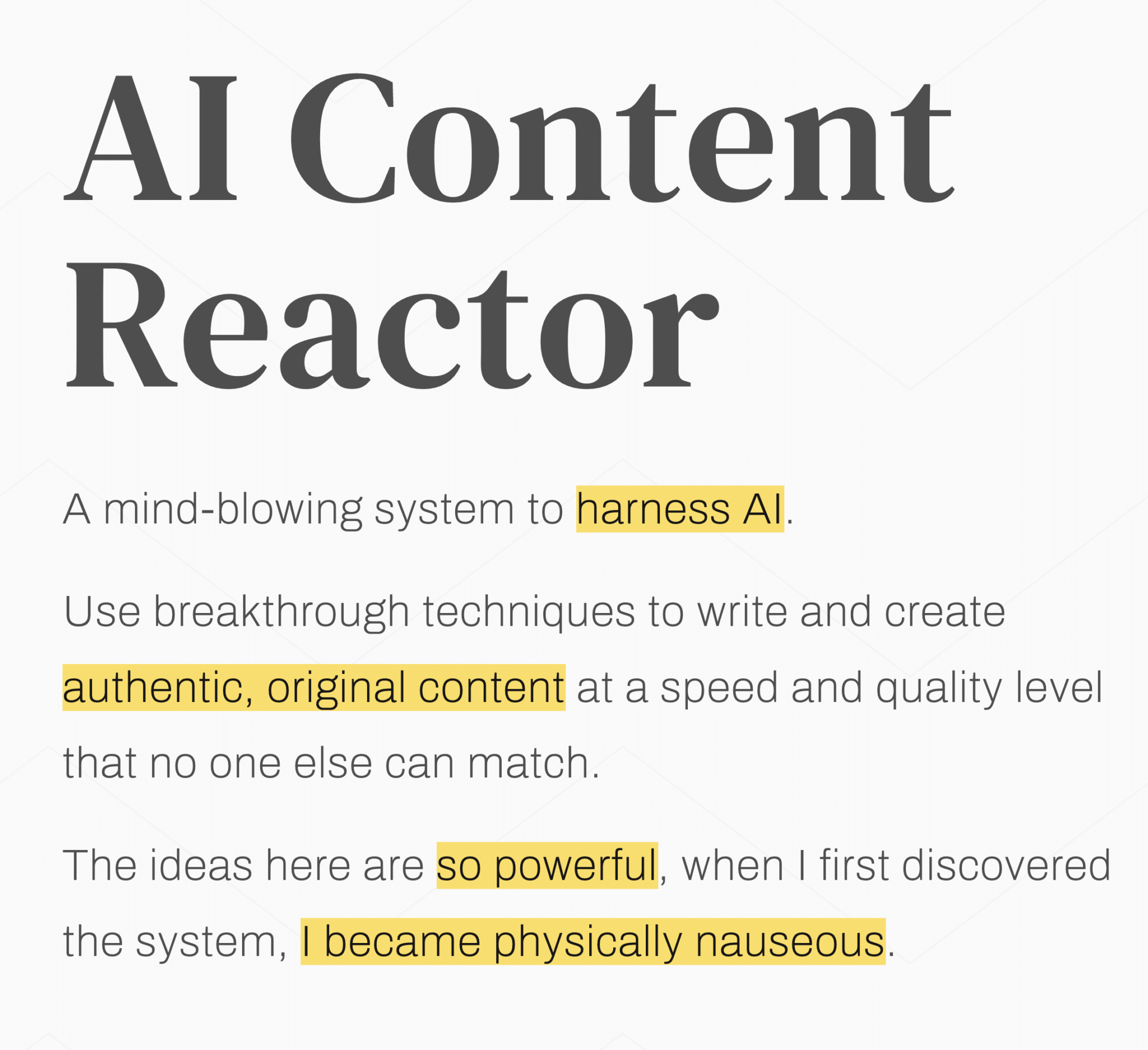The original version of this article, “Building Your SEO Content” (no longer available), was written in simple terms anyone can understand. Write articles rich in content and key terms. Even then, we were cautioning businesses to keep the terms to a minimum, and not overpower the content with SEO. Yet, we also spoke about things like article directories and Ezine sites.
Yes, indeed – many things have changed. One of the biggest things to change is our own approach to content development and marketing; you can’t help but grow your understanding when you put things in practice on a daily basis.
Content Domination
We recently wrote about content domination – using content to stay ahead of the competition. However, the focus of the article was on the competition itself, not on your readership. –And really, what good is dominating in the SERPs if your readers aren’t satisfied? What good is doing anything if it doesn’t translate to growing your readership and sales? To be honest, it doesn’t do you much good at all.
How Much Can You Reasonably Expect Them To Read?
With content domination, it’s easy to get into the habit of pouring out content in a flood. You can, however, ending up washing your readers right out of your pages, articles and blog posts. For example, sometimes Mashable puts out several articles in a day, and you think, “Wow, I wish I could do that!” Not everybody is a Mashable. In fact, most people aren’t.
Here’s the deal. Mashable has a wide audience, and they cater to that audience. They have people who follow specific sections rather than everything that comes across the wire. Therefore, when they post several articles in a day, they’re targeting sections of their audience. They don’t expect all their readers to read every article.
What about you? Are you bombarding your readers with content? Are you putting out three or four posts a day, without targeting specific areas of your site? For that matter, do you even have specific areas of your site?
For example, at the top of our blog, you’ll see five categories. Were we to start posting every day, we would:
- Offer an option for readers to subscribe to individual categories.
- Create a single post, per category, per day.
- Provide an option for readers to receive weekly (rather than daily) updates.
In other words, as we increased our output, we would also increase our readers’ ability to control that output.
Using Various Types of Content – Where Should I Put This?
Right now, you’re probably saying, “Wait a minute. If I have to be careful about how much content I put out in a day, how can I possibly dominate?” That’s a great question, and we have a great answer.
Have you ever noticed that there’s more than one type of content? For example, pages (such as about pages, FAQs, whitepapers and so on) tend to hold long-lasting information that doesn’t need tweaking often. Blog posts, on the other hand, tend to hold information that doesn’t last as long, while press releases and news pieces have a short period of freshness.
When you’re publishing high amounts of content, you have to keep these “types” in mind. By creating a content strategy that allows for freshness issues, you can provide the copy needed without overwhelming your readers. Here’s how it works:
Step 1: Define the freshness of the content.
Decide whether the information is long lasting, and how often it might need to updating. If it’s long lasting information, consider creating a page rather than a blog post or article.
Step 2: Define the purpose of the content.
Understand that building content for SEO purposes should never be the main goal of any piece of copy. The goals should always be to:
- Create a constant, growing source of information (your website and online presence)
- Create copy that informs, entertains and helps the reader in some way
- Create copy that causes conversation, engagement and interest
With this in mind, the next step is to define whether a specific piece of copy’s main goal is to grow the amount of information available on your site, keep your readers informed or create engagement.
Step 3: Separate content pieces into freshness categories.
You can choose how to name your categories, but the categories should define the freshness of the content. We use static (long lasting information), transitional (medium freshness use) and dynamic (timely pieces or those that will need updated quickly).
For the most part, your work is done. Static copy generally makes strong pages. Transitional makes for strong blog posts; dynamic makes for good news releases or occasional blog posts. However, a final step will help further define your content output.
Step 4: Check your work.

For each piece of copy, follow the checklist before publication:
- Will this piece expire within a week? If yes, it’s a news piece. Go to #4. If no, go to #2.
- Will this piece expire within six months? If yes, it’s a blog post. Go to #8. If no, go to #3.
- Will this piece need to be updated regularly? If no, it’s a page. Go to #5. If yes, go to #8.
- If this is a news piece, can it be used as a press release? If no, it’s a blog post. If yes, stop and use it as a press release.
- This is a page. Can it be made into a whitepaper and/or case study? If yes, stop and use it as a whitepaper and/or case study. If no, go to #6.
- This is a page. Can it be made into a FAQ? If yes, use it as a FAQ. If no, go to #7.
- This is a page. Can it be made into a static article? If yes, make it a static article. If no, and the information can’t be included in a pre-existing page, it’s a blog post. Go to #8.
- This is a blog post. Make sure it’s highly readable, easy to understand and interesting. Read aloud for grammatical and spelling errors. Go to #9.
- This is a blog post. Schedule for the appropriate category. Go to #10.
- Rinse and repeat.
Want to save this checklist? Download the Content Freshness Checklist (PNG infograph).
Watch, Listen and Learn
As you watch the SERPs, your rankings and your traffic flow, don’t forget to also watch the conversation. Which blog posts brought the most inbound links and social engagement? It’s easy to be caught up in ranking and traffic, but without engagement and conversation, all the content in the world won’t do you much good. By paying attention to the topics, tone, headlines and so on that bring the most interest, you can apply what you learn to future posts, articles, and whitepapers.
Remember, the main goals for any business’ content marketing are to increase authority, trust and engagement. When you have those, the traffic will come on its own.




































24 Responses
The biggest changes to SEO have happened over the past two years from early 2011 to early 2013, with all the new algorithm updates. These updates were initiated after the cleanup of Google Adwords, so the writing was always on the wall, the search engines (Google in particular) had become cluttered with poor quality content so it’s was the inevitable outcome. The reality is that people had grown comfortable pumping out rubbish and making a great of money doing so, that it’d become nearly impossible to convince people to do otherwise, and we can see this by those peoples actions. The moment the updates hit, many of these people simply threw in the towel. Anyway, some insightful tips on writing content.
The good news is, hooray for companies that have been cranking out relevant content! 😉 Thanks for dropping by Rodger.
Awesome, this was a definitely nice post. In idea I would like to put in writing like this in addition – taking time and actual effort to create a extremely beneficial article?- but what can I say?- I procrastinate alot and by no means seem to get some thing done.
Book Cheap London Hotel
Right Click. Save Image As.
What an unbelieveably straight-forward, yet insightful and powerful resource. You guys are unreal!! 🙂
LOL Hey Darcy thanks. I’ll admit this is one of my favorite posts including (infographic) 🙂
I’m a big for of that particular info-graphic! SEO does change about as frequently as every new ipad release, however, people seem to have always struggled with the content side of thing. I think it had a lot to do with the ‘get-in, get-rich, get-out’ type sites that a lot of people were trying to set up. Heaps of content, minimal quality. They were rubbish, adsense-money grabs and I’m thrilled to see that Google’s latest round of updates have seen them on their way! Content should be created with the topic/purpose in mind and then shaped to accomodate SEO, not the other way around.
You’ve done a swell job of clearly defining the difference between content types and I was one of those people that was thinking, ‘“Wait a minute. If I have to be careful about how much content I put out in a day, how can I possibly dominate?” so I appreciate your great answer! 🙂
Great Post,
I quite enjoyed the Content Freshness Table. I would also have to agree with Wasim, the last line really sums up the overall goal that people should be striving for.
Cheers,
Hello!
My name is Frances Johns and I am getting in touch with you to let you know that your content has been featured on the RankPop.com blog! I’ve included the URL of the post at the end of this message, please stop by and let me know what you think. If you’re happy with the way your content is featured you don’t need to take any action; if you’d like something changed please get in touch with me personally, I’m always happy to help!
Post URL: http://www.rankpop.com/first-rate-content-marketing-catering-to-your-audience/
Regards,
~Frances
Thanks Frances, it’s an honor and a pleasure!
Content should be written for readers, with SEO in mind, not for SEO with readers in mind.
The checklist in number 4 is great for people like me who like to do things step by step; often difficult in such a changing environment such as SEO. Terrific infographic!
Thank you Kate 🙂
Love the Content Freshness Checklist – tasty!
The pics do make me want to fresh squeeze an orange… 😉 Thanks Dana!!
Great post, love the last line, it sums everything up, overall the purpose of your online business is to gain awareness, and build your brand, content marketing is one of the avenues where business can start to build their authority and start their engagement with their followers.
Nice one.
I love #1 – Freshness.
I really try to avoid RTing any post that has no date.
I fully agree ! Sheesh, if you’re not dating your posts – use a page 🙂
It’s really interesting what you say about updating. Time for testing it 😉
Ciao Abel, nice to see you here. I would love to hear your feedback once you do take this on. 🙂
Making even small changes to an existing post or article helps prolong the over shelf life. Updating the title, structure and keywords will all have a positive effect.
Unfortunately with real estate blogs like mine updating old content is not feasible. Our audience reads us for the latest news on the local real estate market, new house listings, the latest house prices and so on. This leads to a constant stream of new posts and listings, as opposed to regularly updates of old content.
I don’t know about that… how about when you’re showing a house? Wouldn’t you be willing to write a post about how to prepare a house (new paint, clean the garden, add new trellis)? We’ve worked with a few realtors and I’ve heard this argument before.
Basically, if you are dealing with new listings that’s one side of your content. However, etiquette regarding what to do with families that have children while showing a new home, or maybe the best way to show off your flower garden… those ideas never get old and can always get a new fresh take. Or how about new leads? Maybe back in 2011 you got most of your leads from your Facebook, but today you would start looking at places like Pinterest or even Google + (okay, probably not G+, but Pinterest might actually be a place to party). There really is no vertical that can’t benefit from this form of spring-cleaning or content regeneration.
Nice graphic Gabriella, how do you determine when to update a living page? Let’s say I write a page on “how to apply peacock eyeshadow” and it’s an evergreen topic. How does one determine the shelf life for such a piece of copy?
Oo – evergreen topics. That’s a good question, Jey. But then again, do evergreen topics, in reality, even have a shelf life? When you’re talking about topics that never fade and are always interesting, they’d have to be scheduled under the content audit process. (Personally, if you’re creating an evergreen forest, I’d keep an excel sheet specifically for those types of articles).
For those that have tons of content, we recommend quarterly reviews. For those that have smaller sites, we recommend a review every six months. If you look at it that way, evergreen copy has a review shelf life of 4 to 6 months.
The only question then is: do I make it a page or a blog post? The answer is: it depends on your site and your current needs at the time. For something like “how to apply peacock eye shadow”, I’d think seriously about creating a section specifically for this type of topic – a mini-hub of information to build on. Hope I’ve answered your questions….
Thank you Gabriella, you have answered my questions.